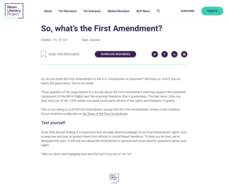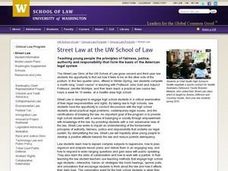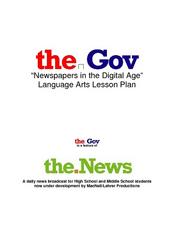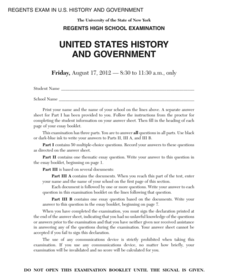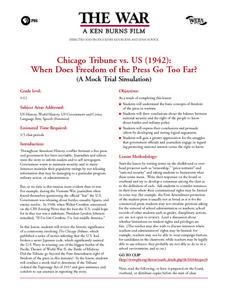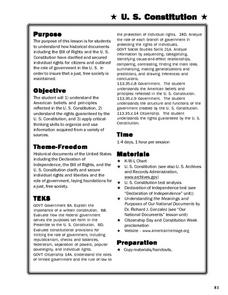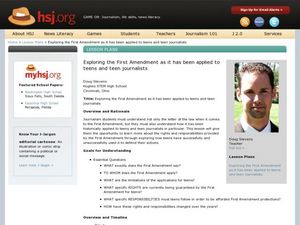National Woman's History Museum
Introduction to Activism
Activist, feminist, and labor organizer Dolores Huerta are perhaps best known for her work with Cesar Chavez to create the United Farm Workers. Class members explore primary source documents to learn more about this Medal of Freedom winner.
News Literacy Project
So, What’s the First Amendment?
The First Amendment to the US Constitution protects people's rights to speech, the press, and religion. Using the resource, scholars discover how. They take a brief online quiz to determine how well they understand the First Amendment.
Facing History and Ourselves
Denial and Free Speech
Learners explore the meaning and implications of genocide. For this Armenian genocide activity, learners investigate the genocide that took place in Turkey.
Curated OER
Free Speech Comes At a Price
Learners use communicative activity strategy, Go, Ask and Tell, or more traditional whole text comprehension activity to read, discuss and explore issues in article, Free Speech Comes at a Price, by Hugh Mackay.
Curated OER
VA Statute for Religious Freedom, III
Students analyze the Virginia Statute for Religious Freedoms and consider its implications. In this governing principles lesson, students explore primary and secondary sources regarding the document penned by Thomas Jefferson.
Curated OER
Pornography Debate
Present your seniors with a controversial topic while studying the first amendment: pornography. This multi-layer resource has scholars writing a pros and cons research paper. They also attend a city council meeting to prepare for an...
Curated OER
Individual Rights and Liberties: Free Speech
Learners review free speech laws and the First Amendment in the Constitution. They discuss a current event involving free speech. They present the information to the class.
Curated OER
The Four Freedoms
Seventh graders consider the freedoms they hold dear. In this historical perspectives lesson, 7th graders identify 4 freedoms that they have and then compare them to the listed freedoms in Franklin D. Roosevelt's "Four Freedoms" speech.
National Endowment for the Humanities
Oyez! Oyez! Oyez!: Simulating the Supreme Court
Students have freedom of speech—or do they? Using an actual court case and research materials on the Supreme Court, young legal scholars examine the Supreme Court's role and history. Then, they argue a case the court declined to hear and...
Curated OER
Newspapers in the Digital Age
Is journalism more or less reliable with the influx of Internet sources? Learners investigate the issues of freedom of speech, journalistic ethics, and social responsibility in the age of Twitter and Facebook. After examining the...
Administrative Office of the US Courts
Snyder v. Phelps
Does the Westboro Baptist Church have the protection of the Constitution when protesting military funerals? High schoolers examine the 2011 Supreme Court case of Snyder v. Phelps before comparing the situation to a fictional scenario of...
Reading Through History
The March on Washington
How does marching get a point across to the government? Teach pupils about civics, human rights, and freedom of speech using the resource about the March on Washington. After reading, learners complete multiple-choice and short-answer...
New York State Education Department
US History and Government Examination: August 2012
Just how far can the American government go during war time? With primary source documents, learners consider the effects on restrictions of freedom of speech, the detention of American citizens of Japanese descent, and the Patriot Act...
Curated OER
The Bill of Rights and You
The right to life, liberty, and the pursuit of happiness. The instructional activity explains what the Bill of Rights is and how it applies to everyday life, like freedom of speech or the right to a jury trial. Young historians complete...
Heritage Foundation
Substantive Amendments: Amendments I and II
The First and Second Amendments remain some of the most famous, even to this day. Learners read about several clauses from the US Constitution through a variety of captivating activities including before and after reading, group work,...
Curated OER
Module 11--Rules and Freedom
In this verb usage worksheet, students determine if ten rules are true or false and if false change the underlined verb so that they are true. Students match five laws that were put into practice with the time period that they were...
Curated OER
Freedom for All? The Contradictions of Slavery and Freedom in the Maryland
Students are be able to analyze the contrast between the rights and privileges referenced in the Declaration of Independence and the Maryland State Constitution in comparison to the rights and privileges of slaves. They are be able to...
Curated OER
The Alien and Sedition Acts: Defining American Freedom
Students analyze the Alien and Sedition Acts. In this Bill of Rights lesson, students listen to their instructor present a lecture regarding the details of the Alien Act and the Sedition Acts. Students examine Supreme Court cases...
Freeology
Martin Luther King, Jr.'s "I Have a Dream"
Dr. Martin Luther King, Jr.'s speech "I Have A Dream" is hailed as one of the most eloquent and moving speeches of the 20th century. But what makes his words hit his listeners' ears in just the right ways? Young orators study Dr. King's...
Administrative Office of the US Courts
Texas v. Johnson
Which right does the Constitution weigh more heavily: the sanctity of the American flag as a symbol of national unity, or the right to burn the flag in protest? The 1989 Supreme Court case of Texas v. Johnson explores a state's right to...
Curated OER
Chicago Tribune vs. US (1942): When Does Freedom of the Press Go Too Far?
Students define freedom of the press in peace and war time. As a class, they identify the need for the public to be informed, but discuss where the line should be drawn to protect national security. They develop their arguments and...
Curated OER
Constitutional Rights
Students read an account of a students reaction to the Vietnam War. They complete comprehension questions from the reading passage. They read arguments from the Supreme Court Justices and decide which arguments they agree with.
Curated OER
Exploring the First Amendment as it has been applied to Teen Journalists
Young scholars explore the First Amendment as it has been applied to teens and teen journalists. In this First Amendment lesson, students memorize the First Amendment, complete online research of the topic, and quiz. Young scholars read...
Judicial Learning Center
The Constitution and Rights
What's the right way to teach young historians about the Bill of Rights? Many an instructor has asked this question when pondering lesson plans over the US Constitution. The Constitution and Rights is a nifty resource that provides a...
Other popular searches
- Journalism Freedom of Speech
- Censorship Freedom of Speech
- Freedom of Speech Obama
- Canadian Freedom of Speech
- Freedom of Speech Music
- Freedom of Speech Readings
- Limited Freedom of Speech
- Freedom of Speech Abm
- Freedom of Speech and Press



